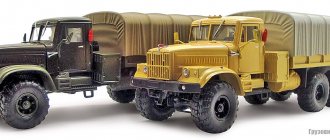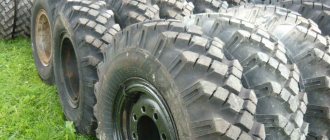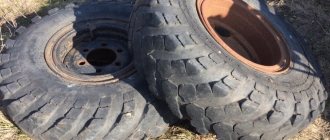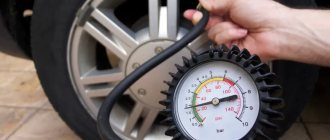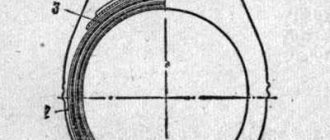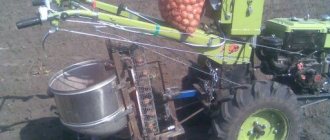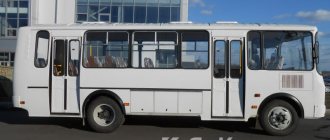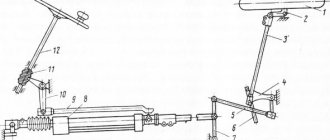Tire Vi-3 chamber 2-ply 1300×530-21
Catalog categories
Description:
- Marking: AT 1300×530-21″ K
- Ply: 2
- Outer size: 1300 mm
- Profile width: 530 mm
- Weight: 80 kg
- Max. permissible speed: 50 km/h
The legendary tire from Kraz “Laptezhnik” with a reduced number of layers 1300×530-533 is designed to increase the cross-country ability of wheeled all-terrain vehicles such as Niva-Marsh, Niva-Bronto, Trekol, UAZ, GAZ and others.
The aggressive tread pattern does not become clogged with dirt and effectively “shoves” out dirt, sand, and wet grass, preventing the all-terrain vehicle from getting stuck and “drowning” in the mud. Thanks to the tread pattern typical of all-terrain tires, the tire also works effectively on snow or ice. The 1300x530-21” tire is perfectly mounted on the rim of the Trekol all-terrain vehicle, since its seat size fully corresponds to the dimensions of the tires produced by NPF Trekol LLC. The 1300×530-21” tire is available in a tube version. Tire type – diagonal.
Specifications
| TIRE SIZE | 1300х530-533(21) |
| EXECUTION | Chamber (TT) |
| TREAD PATTERN | Christmas tree |
| GROUND HEIGHT (mm) | 21 |
| SLAVE. PRESSURE (atm) | 0,3 — 0,8 |
| OUTER DIAMETER (mm) | 1300 |
| PROFILE WIDTH (mm) | 530 |
| FITTING DIAMETER (mm) | 533 |
| MAX. SPEED (km/h) | 50 |
| LAYERITY | 2 |
| MAX. LOAD (kg) | 800 |
| TIRE WEIGHT (kg) | 80 |
| DISC WEIGHT (kg) | 27,5 |
| TIRE VOLUME (m^3) | 0,89 |
| DISPLACEMENT (m^3) | 0,51 |
Discs
Disc with beadlocks for UAZ/Niva hub, offset 120-170-220mm
Disc with beadlocks for GAZ-66 hub, offset 180mm
Application
SUVs (UAZ, NIVA, TOYOTA, etc.), NIVA-MARCH, Trekol all-terrain vehicles, all-terrain vehicles based on GAZ-66 and truck axle bases
Source
Characteristics of the Soviet heavy all-terrain truck KrAZ-255B Laptezhnik
The KrAZ-255B truck, nicknamed “Laptezhniki” for its characteristic off-road tires, was created on the basis of vehicles from the Yaroslavl Automobile Plant. The development of drawings and technological documentation began in the early 60s of the 20th century. Serial production began in 1967; in total, about 161 thousand cars of various modifications were built. During the production process, the equipment was modernized several times, but the appearance changed slightly.
How much does a Kraz Laptezhnik tire weigh?
Wheels and tires of KrAZ-255B and KrAZ-255V vehicles
The car is equipped with discless wheels of size
440-533 mm with tube tires 1300X530-533 according to GOST 13298-78.
Rim width for tire, mm. 440
Mounting diameter of the rim for the tire, mm 533 Weight of the wheel assembled with the tire, kg. . . 225
The wheel (Fig. 25) consists of a tire 4 with a tube and rim tape*, a rim 8, two bead rings 3 and 7, a seat ring 2 and a lock ring 1. The wheels are mounted on the conical surfaces of discless hubs and secured to them with six clamps.
The tires are twelve-ply low-pressure pneumatic cylinders with a directional tread pattern. The nominal air pressure in tires is 3.5 kgf/cm2, adjustable to 1 kgf/cm2 depending on road conditions.
Installation and dismantling of tires must be carried out at a tire workshop using special equipment, devices and tools, under conditions that prevent dirt from getting on the tubes and tires. The use of sledgehammers is prohibited. It is permissible to use a wooden hammer to tap the tire while pumping air into it and to ensure a more reliable fit of the bead and the rim lock ring.
Tires, tubes and rim tapes must be clean and dry before installation. Tires stored at ambient temperatures below zero should be warmed to above-zero temperatures before installation. Before installation, the tire (inside), tube and rim tape must be powdered with talc over the entire surface, and excess talc must be removed. When installing tires, make sure that the inner tube valve is in the correct position, preventing it from being distorted. Rims, beads and locking rings must be of the correct shape, without deformation or damage, cleaned of rust and painted.
When installing tires with a directional tread pattern, it is necessary to take into account the direction of the tread pattern and the location of the wheels on the vehicle. This will ensure a match
tire rotation direction indicators (arrows on the sidewalls of the tires) indicating the direction of wheel rotation when the vehicle moves forward.
When inflating tires, it is not recommended to unscrew the spool valves, since the driver's tool kit contains a hose with a special tip that ensures pressure on the spool valve needle for free flow of air into the chamber.
Rules for using tires
- It is not recommended to park the car in a place contaminated with petroleum products and other aggressive liquids that destroy rubber. Wheels should not be located closer than 1 m from heating devices and fire sources.
- It is forbidden to leave a car with tire pressure that does not meet the standards.
- Tires, tubes and rims damaged during use, as well as tires with extreme tread wear, must be removed from the vehicle and sent for refurbishment.
- If there is heavy or uneven tire wear, you must determine the cause and take action to correct the problem, no matter how long it may take.
- Reinstallation of tires is recommended only if a need is identified, which is determined by the technical manager of the automotive industry or enterprise. The basis for rearranging wheels can be uneven or intense wear of the pattern, the need for the correct selection of tires for the axles, installation of more reliable tires on the front axle, and the like.
- Rotation of directional tires should be done to ensure the least even tread wear on all tires, regardless of which pattern is recommended.
Features of choosing tires for a truck
Wheels for your tractor and trailer should be selected based on the principles of safety, handling and quality , and not on appearance. Installing large and beautiful wheels that will catch your eye is not able to save lives on the road. This type of tuning is not for truck drivers.
Correctly selected tires on the truck and its trailer will ensure better maneuverability and controllability on the road.
It is very important to be safe and careful when parking near warehouses, so as not to rub your tires against the wheel guides for trucks or the bump stops that serve as stops. They guide the trailer to the warehouse unloading gate and protect the loading equipment from damage. These devices make parking long car transporters much easier.
Poor quality tires and their incorrect and too long use lead to wheel explosions. If this happens while driving at high speed, the car may get into an accident and cause damage to other cars on the road.
You can see what a wheel explosion looks like here:
Important! It is best to buy tires from trusted sellers. On the Internet, there is a risk of running into scammers and receiving low-quality goods or not receiving your order at all.
Device and technical characteristics
The KrAZ-255B1 all-terrain vehicle is built on a frame equipped with side members made of standard channel bars, which are connected by 5 stamped cross members. The front axle is mounted on springs, the ends of which are installed in rubber damping supports. To reduce rigidity, telescopic shock absorbers are used. The rear bogie is equipped with a balancing suspension, which includes springs and reaction bars.
Discless wheels are equipped with removable bead rings. The truck uses model VI 3 tires with a size of 1300*530. The standard equipment includes a centralized pressure control system, the control valve is located in the driver's cabin.
Technical characteristics of the base car:
- load capacity - 7500 kg;
- trailer weight - 30,000 kg (on paved roads);
- maximum speed - 71 km/h;
- control fuel consumption - 40 liters per 100 km;
- fuel range - 750 km;
- ford depth - up to 1.0 m;
- climbability on dry hard surfaces - 18-20° (depending on weight);
- braking distance (when driving at a speed of 40 km/h) - no more than 21 m.
The truck tractor built on the KrAZ-255 base uses a frame shortened by 960 mm. The 2-pivot saddle is designed for the use of semi-trailers with a king pin with a diameter of 50.8 mm. Locking is done semi-automatically; the trailer can be tilted 100° in each direction.
The dump truck, based on an all-terrain vehicle, was equipped with a metal platform without a tailgate. A hydraulic system was used to tip the unit. The pump was installed on transmission units.
An army excavator EOV-4421, intended for the creation of fortifications, was mounted on the basis of the truck chassis. The installation was equipped with a separate SMD 14 diesel engine, which drove the pumping station.
The 255L1 version of the timber truck uses simplified units from model 256 civilian trucks. The vehicles were supplied complete with a spreader trailer, which made it possible to transport logs up to 30 m long and weighing up to 23,000 kg.
Engine
The 255B trucks used a 4-stroke YaMZ-238 engine with compression ignition of the fuel mixture. The engine has 8 cylinders installed in a V-shape with a camber angle of 90°. The cooling system uses a tubular radiator covered in front by manually operated shutters. An additional heat exchanger for the lubrication system is installed in front of the curtain.
The engine is equipped with a friction clutch with 2 discs and a damper device. The unit is controlled mechanically; the design does not provide for an amplifier.
The power unit develops a power of 240 hp, while the specific fuel consumption does not exceed 175 g/hp*h.
The exhaust system uses corrugated hoses. The standard equipment of the trucks included an autonomous starting heater model PZD-44B.
Truck tires
Properly selected tires for a truck will improve the performance properties of the vehicle and extend its service life, as well as:
- reduce fuel consumption;
- lighten the load on the suspension and engine;
- increase truck safety when driving;
- eliminate constant repairs and replacement of unsuitable tires.
Truck tires in warehouse
Important! When choosing wheels for your truck, you need to pay attention not only to the size and type, but also to the manufacturer and quality of the products. Cheap tires will wear out faster and require urgent replacement.
Types
The front and rear of trucks have different types of tires depending on the purpose of the axles:
- helmsmen;
- presenters;
- trailed
Truck axles on a semi-trailer must respond well to steering wheel turns, and for this, the tires need to be able to provide the required level of vehicle maneuverability.
The drive axles are most often rear axles; the tires on them are installed in such a way that they provide good grip on the road and create the required traction parameters.
Types of truck tires
For installation on trailers and semi-trailers, tires are used that maneuver well when turning and ensure driving safety. These tires have a larger tread area.
By the way! Heavy trucks have dual rear wheels. This provides better stability and load capacity.
Classification
Truck tires are divided not only by type, but also by season and size. Tires are distinguished:
- summer;
- winter;
- all-season.
All-season tires are produced for trucks , but in rare cases, winter tires are put on some models. It costs significantly more than summer and all-season ones, so drivers prefer not to “change their shoes.”
All-season tire
Winter tires for trucks are produced without studs, since due to the heavy weight of the vehicle, they can spoil the quality of the road surface, and the material of the tires themselves wears out faster. In situations where trucks have difficulty moving on ice, drivers use chains, and it is not economically profitable for manufacturers to produce special winter tires and stud them, since their cost and installation are very high for truckers.
Winter tires for trucks
Tire size classes are designated by numbers and are indicated when marked on each wheel.
Marking
Truck tires always indicate:
- main dimensions, width, profile height, rim diameter;
- permissible load;
- speed index;
- name and country of the manufacturer;
- area of application by tire type (rear or front, external or internal);
- design features (radial or diagonal, tube or tubeless, direction of rotation, reinforced or not, etc.);
- marks of compliance with regulatory documents.
In the photo you can see the main symbols used when marking tires.
Symbols on the bus and their designations
For example, in the designation 385/65 R22.5, 385 is the tire width in mm, 65 is the profile height in percent, R indicates the radial position, and 22.5 is the rim diameter in inches.
What affects tire weight?
The tire will weigh more when inflated. Due to the pressure created inside the tube or in the space between the disc and the tire, the weight of the wheel will increase. In addition, the materials from which tires are made differ in their characteristics, including weight. Inside the tire there is a metal cord that strengthens the structure of the product. Manufacturers can use metal of different weights.
By the way! Truck tires differ from passenger tires in that they have a metal cord. For passenger car wheels it is made from other materials.
Bus internals
Tire size range
The main size for a wheel is its inch diameter . In all catalogs and labeling, it is customary to sort the model range precisely by its designation. Trucks are equipped with tires with a diameter of 15 to 32 inches , depending on the model and load capacity of the vehicle.
For your information! For the convenience of customers, online stores post tire calculators on their websites to calculate tire sizes.


